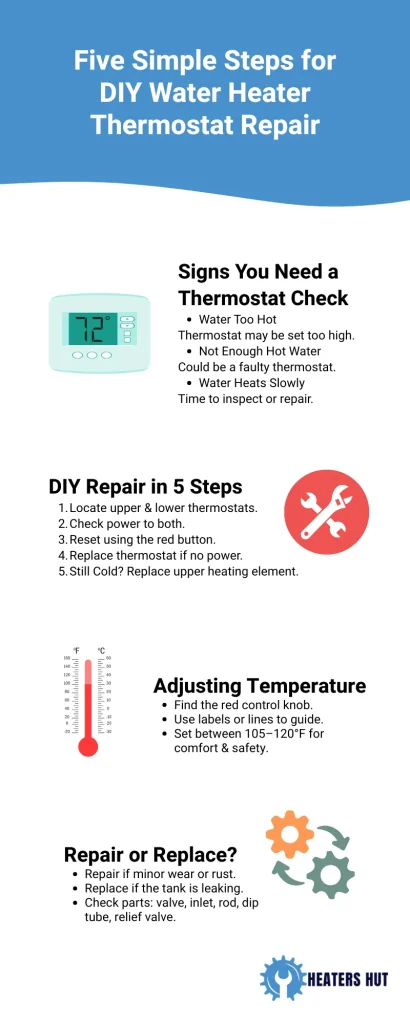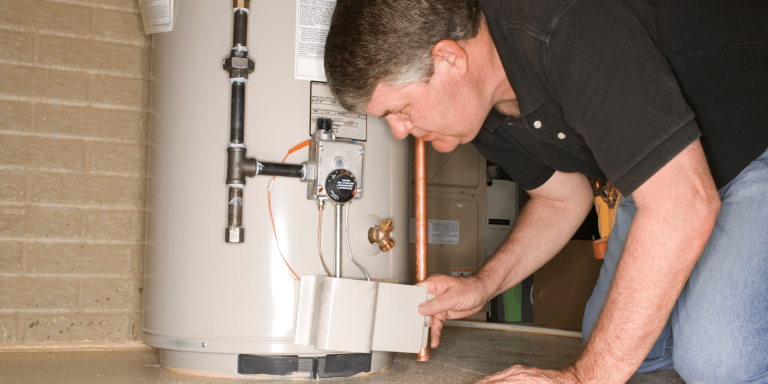Introduction:
Hot water is essential in our daily life. Whether washing dishes, doing laundry, or taking a hot shower, we rely on water heaters to provide these luxuries. What do you do when your water heater doesn’t work anymore? This blog post will walk you through a simple DIY process for repairing a water heater thermostat. We’ll also help you identify when to repair or replace your thermostat and highlight common signs of thermostat problems.

Signs Your Water Heater Thermostat Needs Repair
So, how do you know if your thermostat needs some attention? Watch for these signs:
Water Is Too Hot:
If your water burns hot, you may have set your thermostat too high.
Not Enough Hot Water:
Cold showers? This issue could be due to a faulty thermostat or other problems.
Water Takes Forever to Reheat:
Electric heaters, mainly, can be slow. If it’s taking longer than usual to warm up, it’s time to investigate.
Maintaining your thermostat to avoid burns or damage from boiling water is essential. It’s a key part of overall hot water heater safety.
DIY Thermostat Repair in 5 Simple Steps
Now, let’s roll up our sleeves and fix that thermostat. Follow these five simple steps:
1. Locate Upper and Lower Thermostats:
Find these on the water heater.
2. Check Power Supply:
Use a multimeter to test for 240 volts across the thermostat terminals. No power? Check the breaker or wiring before proceeding.
3. Reset the Thermostat:
The most common fix is a simple reset. Press the small red reset button on the upper thermostat. A click usually means it has reset. If it immediately trips again, the thermostat or heating element could be faulty. For more on this, read our blog on how to reset a Rheem water heater.
4. Replace the Thermostat:
If the upper thermostat has power but no response, remove the old unit. Detach wires, unscrew the bracket, and install a compatible replacement. Repeat for the lower thermostat if needed.
5. No Hot Water? Replace the Upper Heating Element:
If electricity flows but water stays cold, your upper heating element may be the issue, not the thermostat. Use a multimeter to test for continuity and replace if necessary.
These straightforward steps can get your thermostat back on track.
Adjusting Water Temperature
Getting the proper water temperature is crucial. Here’s how:
1. Locate the Temperature Control Knob:
The thermostat dial is usually marked in red with notches labeled “Warm” or “Hot.”
2. Adjust Between 105 and 120 Degrees Fahrenheit:
Use a flathead screwdriver to set the temperature between 105 and 120 degrees Fahrenheit. This range prevents scalding while keeping energy use in check.
3. Test After Adjustment
Wait a few hours, then test the water temperature from a faucet. Re-adjust if needed.
When to Repair or Replace a Water Heater Thermostat
If your thermostat is the only failing part, replacement is usually enough. But some issues point to bigger problems:
Tank Leaks
If the water heater tank is leaking, it’s beyond repair. A complete replacement is required to prevent home damage.
Visible Corrosion or Rust
Surface rust is manageable, but corrosion near valves or seams can lead to failure.
Component Failure
Problems with the anode rod, dip tube, or T&P valve, especially on an older unit, may justify replacing the entire unit rather than just one component. You should also check if your unit is still under warranty. Our Rheem water heater warranty guide can help with this.
Consult a plumber if you’re unsure whether repair or replacement is more cost-effective.
Conclusion:
Finally, a malfunctioning water heater thermostat can disrupt our daily routines and comfort, but with these simple DIY steps, you can often fix the problem without professional help. By recognizing the signs of thermostat problems early, you can take proactive steps to ensure that your hot water supply remains consistent and safe. However, it’s essential to understand that situations may sometimes extend beyond the thermostat, and other water heater components may need attention or replacement. When faced with extensive problems like leaking tanks, it is advisable to consult a professional to avoid potential damage to your home.
For all your water heating needs and expert advice, visit Heaters Hut.






